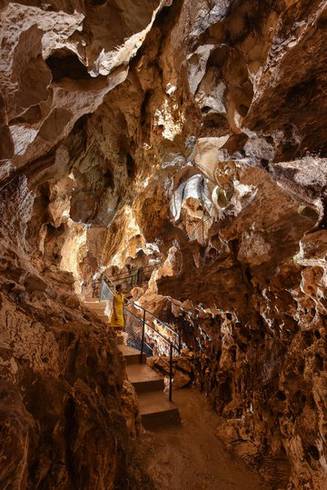The Grotte de Thaïs: an underground world
at the heart of a picturesque village
Between Valence and Grenoble, at the gateway to the Vercors, the Grotte de Thaïs nestles at the heart of Saint-Nazaire-en-Royans.
This medieval village is famous for its aqueduct, which overlooks the River Isère impoundment lake and its Paddlewheel Boat, at the confluence with the River Bourne.
During a tour lasting about an hour, your guide will tell you about how this cavity formed, its occupation during the Ice Age, techniques for sharpening flint and lighting fires, and the ongoing explorations of the cavern siphon.
So you have a successful excursion with family or friends, your guide tailors their presentation to their audience. Feel free to ask questions!
History
The two settlements and the artistic items discovered in the Grotte de Thaïs attest to the presence of Magdalenians, then of Azilians, for more than 3,000 years.
A settlement has been reconstructed, and your guide will explain the everyday life of Homo Sapiens, with activities such as hunting and toolmaking.
One of the items discovered in the cavern is the Os coché No. 250 (now held by the Musée de Valence ). This unique piece - a bone covered in notches - is, to date, the first known form of annotation by humans, and is thought to be some kind of calendar.
The Prehistory sequence of the tour ends with a demonstration of flint sharpening and fire lighting.


Geology of the Grotte de Thaïs
The Grotte de Thaïs illustrates the effects of water and time on rock. You will see the resurgence of the river that carved these labyrinthine galleries. Your guide will explain the mystery of the red and black colours stretching over various types of concretions that are thousands of years old.
Caving and exploration
The tour ends at the point where the flooded area of the cavern begins: 2 km of additional galleries that have already been explored. But what are the size and extent of this underground network? Your guide will explain how we find out a little more each year, thanks to diving-equipment innovations.


On the trail of Homo Sapiens
Man arrived in Saint-Nazaire-en-Royans circa 15,000 BC. At that time, the environs were open and cold, with a temperature of roughly 2-3°C. The Ice Age gradually ended, and temperatures rose: forest developed and Homo Sapiens became sedentary, as he no longer needed to follow animal migrations.
Discovery and conservation:
50 years of touring the Grotte de Thaïs
Development of the cavern began in 1970. The brothers Jean, keen cavers and divers, wanted to combine the tour of the Grotte de Thaïs with the Paddlewheel Boat cruise and the discovery of the Jardin des Fontaines Pétrifiantes in La Sône. This passion for the underground world was confirmed when the company behind the Grotte de Choranche (as well as the paddlewheel boat and the garden) acquired the Grotte de Thaïs in 2014. The latter cavern is now part of a project to save energy with LED lamps, conserve the site, and promote science through archaeological digs.




